Douglas Sirk: From the Archives
“I have no talent for sentimentality,” Douglas Sirk said to James Harvey in the pages of FILM COMMENT in 1978. But film scholarship has happily grappled with the subversive 1950s melodramas of the German director which the critics of Cahiers du cinéma reclaimed as cinematic masterpieces. The inherent contradictions of style and content in melodramas like Written on the Wind (56) and Imitation of Life (59) have been seen as suggesting everything from hilarious comedies to social realist dramas. As Harvey puts it in that same interview, Sirk’s “best work is not easy to like or to come to terms with. But at the least, the mirror-reversals of his surfaces, the almost Nabokov-like density of some of his textures, expand our sense of what is possible in art, and of what is duplicitous too. His films can have an almost unique troubling force.”
On the occasion of the Film Society of Lincoln Center’s retrospective, Imitations of Life: The Films of Douglas Sirk (December 23 – January 6), here is a selection of FILM COMMENT’s meditations on the director’s oeuvre from the last four decades.
“Douglas Sirk: Melo Maestro”
By James McCourt
November/December 1975
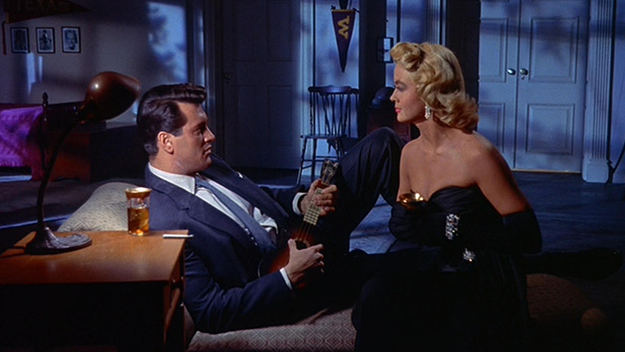
Written on the Wind
Sirk, who’d left Hollywood and the U.S. behind after 1959’s Imitation of Life, found his career rejuvenated within critical circles after the 1971 publication of Jon Halliday’s seminal, book-length interview, Sirk on Sirk. Shortly thereafter, the 1972 edition of the Edinburgh Film Festival programmed a 20-film retrospective, which Sirk attended as a guest. This newfound interest in the English-speaking world led to pieces such as this one by writer James McCourt, whose debut novel Mawrdew Czgowchwz had just been published in January 1975. Cheekily addressed to The Literate Serious (or TLS) who continued to look down on Sirk, McCourt’s piece offered “an appreciation of four Sirkian masterpieces of the Fifties”—Written on the Wind, All That Heaven Allows, The Tarnished Angels, and Imitation of Life. McCourt celebrates the director’s “bravura, as it worked simultaneously with and against popular, melodramatic material (‘The Weepies’), turning story circumstances into Sirkianstances.”
Here he is on Imitation of Life:
Sirk’s last picture, a defiantly triumphant melodrama—a kind of tightrope walk to greatness.
Sirk: “I feel Imitation of Life and Written on the Wind … have something in common; it’s the underlying element of hopelessness… In Imitation of Life you don’t believe the happy ending, and you’re not really supposed to. Everything seems to be O.K., but you well know it isn’t.”
The entire picture is trompe l’oreille and a feast for the discerning eye from beginning to end. Never has Lana Turner’s unctuously sincere pear-toned elocution been better pitted against the utter vacuity of her gaze, the deadly precision of her MGM comportment—that walk, that invisible thick of the World’s Great Quotations balanced on that perfectly poised head. Those Jean Louis gowns. It’s all there, perfect imitation of vitality. lf ignorance is a delicate and exotic fruit, whose bloom is gone if ever once touched, the Lana Turner character in Imitation of Life is the Queen of the Mangoes. The perfection of seeming, she can no more be touched—moved to real action—than Narcissus can kiss his image in the reflecting pool. As perfect a contrast and balance to the Juanita Moore character as is black to white, in color.
And desperate it is. Susan Kohner, sitting in a chorus line of chairs, joylessly kicking up one leg, holding a grotesque champagne bottle in the ugliest nite-club in the world (Sirk directing Cabaret… !), and immediately thereafter backstage, turning her back to her mother, sitting in her dressing-table chair, wounded and cruel. Her last permission, her final admission is to her mother, to be embraced one final time. The next embrace is of the flower-decked coffin. Embracing death; leading life. For Sirk, deus-ex-machina, the anodyne.
Poet, debunker, triumphant charlatan, stunner, Hollywood visionary, and magnificent obsessor. Douglas Sirk resides in Picture People’s Paradise.
“Fassbinder on Sirk”
By Rainer Werner Fassbinder
November/December 1975
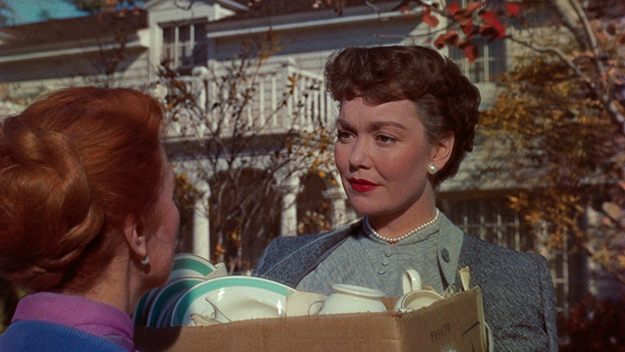
All That Heaven Allows
The Edinburgh Film Festival retrospective led to the publication of a book of essays edited by Laura Mulvey and Jon Halliday. Featuring mostly new materials, the collection also reprinted a translated version of Fassbinder’s 1971 tribute to the German director whom he’d admired and emulated throughout his own work. An excerpt of this piece appeared alongside McCourt’s. Admitting that he’d “left out a lot which might have been more important,” Fassbinder offered succinct analyses of the same four films covered by McCourt, cementing them as the key four films in Sirk’s filmography.
“Film is like a battleground,” Sam Fuller, who once wrote a script for Douglas Sirk, said in a film by Jean-Luc Godard, who, shortly before he made Breathless, wrote a rhapsody on Douglas Sirk’s A Time to Love and a Time to Die. But not one of us, Godard or Fuller or me or anybody else, can touch Douglas Sirk. Sirk has said: “Cinema is blood, is tears, violence, hate, death, and love.” And Sirk has made films with blood, with tears, with violence, hate—films with death and films with love. Sirk has said: you can’t make films about things, you can only make films with things, with people, with light, with flowers, with mirrors, with blood, in fact with all the fantastic things which make life worth living. Sirk has also said: a director’s philosophy is lighting and camera angles. And Sirk has made the tenderest films I know; they are the films of someone who loves people and doesn’t despise them as we do. Darryl F. Zanuck once said to Sirk: “They’ve got to like the movie in Kansas City and in Singapore.” America is really something else.
And on All That Heaven Allows:
This is the kind of thing Douglas Sirk makes movies about. People can’t live alone, but they can’t live together either. This is why his movies are so desperate. All That Heaven Allows opens with a long shot of the small town. The titles appear across it. Which looks very sad. It is followed by a crane shot down to Jane [Wyman]’s house, a friend is just arriving, bringing back some crockery she had borrowed. Really sad! A tracking shot follows the two women, and there, in the background, stands Rock Hudson, blurred, in the way an extra usually stands around in a Hollywood film. And as her friend has no time to have a cup of coffee with Jane, Jane has her coffee with the extra. Still only dose- ups of Jane Wyman, even at this stage. Rock has no real Significance as yet. Once he has, he gets his close-ups too. It’s simple and beautiful. And everybody sees the point.
Douglas Sirk’s films are descriptive. Very few close-ups. Even in shot-counter-shot the other person doesn’t appear fully in the frame. The spectators intense feeling is not a result of identification, but of montage and music. This is why we come out of these movies feeling somewhat dissatisfied. What we have seen is something of other people. And if there’s anything there which concerns you personally, you are at liberty to acknowledge it or to take its meaning with a laugh.
“Sirkumstantial Evidence”
By James Harvey
July/August 1978
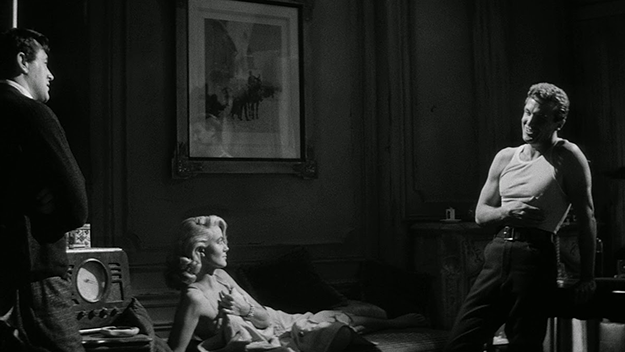
Tarnished Angels
Harvey’s interview with Sirk is prefaced by an author’s note that explains how unhappy the director was with the final result. “Too gabby,” he called it, and too personal. More tellingly, Harvey writes that Sirk, who’d been teaching at the University of Television and Film in Munich, where Fassbinder attended one of his courses, requested to offer some revisions that, in the film critic’s eyes, “offered a version of himself altogether less impressive and engaging than the man I met and talked to.” The result is a candid conversation that finds Sirk wistfully reminiscing about his time in the United States and somewhat ill at ease about his newfound renown.
Your films were never taken seriously in their own time by critics. It must have been astonishing to you to find the career that you’d abandoned taken seriously at last and so many years later.
I didn’t even know that Godard had written about me until Halliday [who interviewed the director for the book Sirk on Sirk] came here. Of course while I was making films I didn’t read reviews. You can’t read them—everyone is saying something different. The first time I had any notion of what you call serious attention was when a French friend sent me a clipping from L’Express in the late Fifties. It said the Academy Awards as usual had slighted the two most important films of the year—Touch of Evil and Tarnished Angels.
“White Melodrama: Douglas Sirk”
By Tag Gallagher
November/December 1998
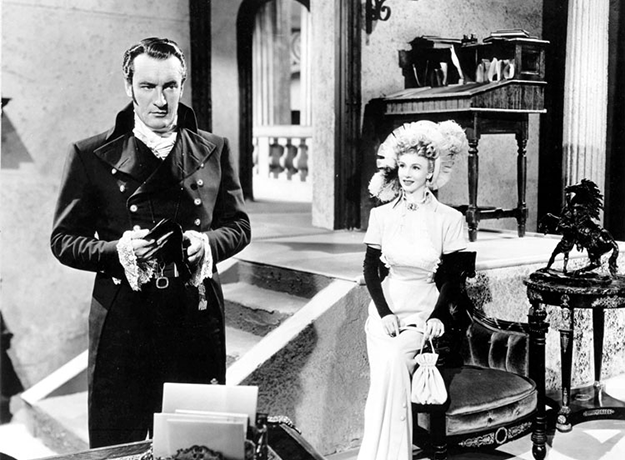
A Scandal in Paris
A decade after Sirk’s death, Tag Gallagher, whose book The Adventures of Roberto Rossellini was about to be, wrote a lengthy piece that looked back yet again at the director’s famed melodramas. Rather than accept Sirk as a master ironist—indeed making a claim for Sirk’s own misunderstood reputation—Gallagher plumbed instead the director’s Germanic philosophical influences. Sirk, he argues, “thought movies should function for society as the plays of Sophocles and Euripides did in ancient Athens. The melodrama plays the audience. Music with the text accentuates emotions, which enact battles of good and evil, light and darkness and movement.” Using Schopenhauer, he discusses the director’s first two American films, Summer Storm (45) and A Scandal in Paris (46), using them as examples of Sirk’s sustained interest on morality, God, and humankind’s Will, issues he exploded in his later melodramas.
To awaken social awareness, Sirk said, had been his goal with Schlussakkord and ever after—while remaining “in the realm of signs and symbols… The angles are the director’s thoughts. The lighting is his philosophy. Even to this extent: long before Wittgenstein and some of my contemporaries learned to distrust language as a true medium and interpreter of reality. So I learned to trust my eyes rather more than the windiness of words.”
Sirk’s emphasis on women, then, was not only political but artistic. Women are great vehicles for the physical emotions of melodrama. We can see Sirk turning angles into thoughts and motions into emotions during the mother-daughter fights between Lana Turner and Sandra Dee near Imitation’s end. Their words are crude, incomplete, theoretical compared to their motions—the motions of their mouths and eyes, but principally Sirk’s constant framings and reframings; the way their bodies retreat and attack within the frame; the sadism and masochism that changes with each change of whose shoulder we’re looking over; finally the way a character drops down out of the frame in defeat (or in change of tactics). “The camera is the main thing here,” Sirk said, “because there is emotion in the motion pictures. Motion is emotion, in a way it can never be in the theatre.” This is why so much of academia’s struggle to grapple with movies is backwards and fraudulent, and blunts rather than encourages our sensitivity to cinema. We have to learn to feel movies.
“Made in Heaven. How is it that Todd Haynes’ warmest film is inspired by Douglas Sirk’s coldest?”
By James Harvey
March/April 2003
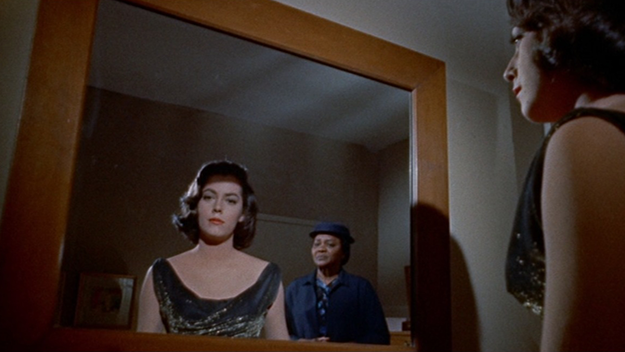
Imitation of Life
“Why, for some of us at least, does Todd Haynes’s Far From Heaven seem so far from Douglas Sirk?” That is the question that animates Harvey’s intervention in what became the de rigueur way of discussing Haynes’s critically acclaimed 2003 film. While he acknowledges the Sirkian influence which permeates the Julianne Moore-starring film, he elaborates instead a critique of what he terms Haynes’s condescension “toward the past—unintended but unmistakable,” which he believes distorts the very things that make Sirk’s filmography so resonant today.
Sirk’s great films are about people who don’t believe in death, made by someone who does. That is the explicit contrast between the black characters and the white ones in Imitation of Life (59), and the implicit one between the “bad” and the good couples in Written on the Wind; between people for whom life is recognizably tragic (Juanita Moore’s Annie in Imitation of Life, Robert Stack in Written on the Wind, Dorothy Malone, the daredevil pilot’s wife, in The Tarnished Angels (59), or Barbara Stanwyck’s “other woman” in There’s Always Tomorrow) and those others—Rock Hudson and Lauren Bacall in Wind, Lana Turner and Sandra Dee in Imitation—who simply refuse that recognition on principle. The distinction between depth and shallowness in his characters is central to Sirk and to the critique of American life these films reflect. And this tragic consciousness pervades them all.
What could be more alien to that than the soft of tasteful heart-tugging you find in Far From Heaven? Like the ending—as Julianne Moore’s Cathy says goodbye to the man she loves but can never be with, as his train pulls away from the platform, as she drives off in her turquoise station wagon (the same color as the one in All That Heaven Allows), as the camera and the music rise. So it’s okay, that moment—the movie has earned that at least, you suppose—and the filmmaker has let you know (has he ever!) that he knows how cliche this all is, so you can relax and enjoy it guilt-free if you want. But then think of what Sirk does for a contrast—Annie’s funeral at the end of Imitation of Life, Marylee’s totentanz at the climax of Written on the Wind. Haynes means to make you cry, as he’s said in interviews. Sirk’s great films mean to wipe you out.







